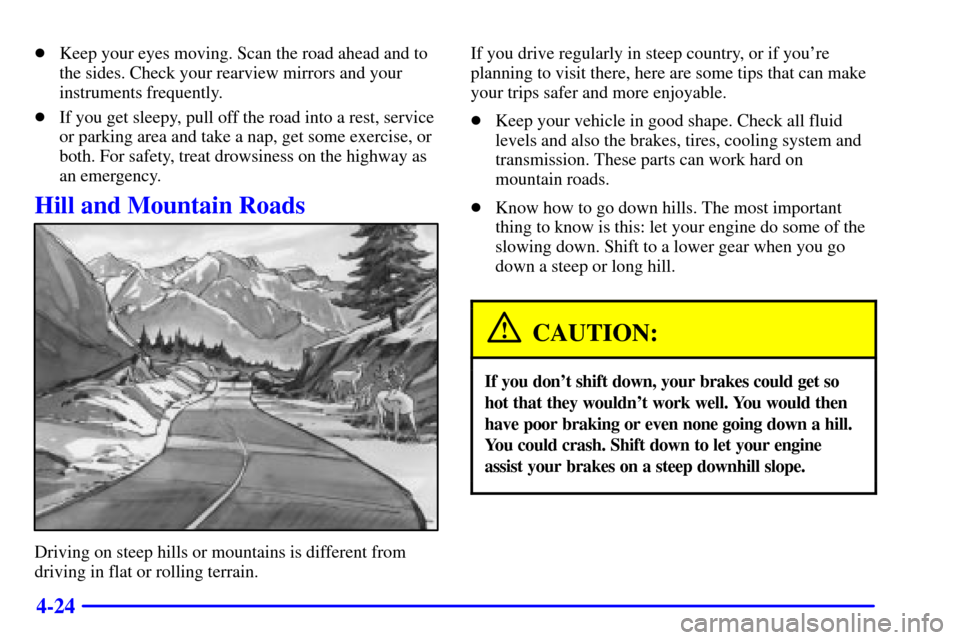Page 185 of 321

4-10
The traction control system automatically comes on
whenever you start your vehicle. To limit wheel spin,
especially in slippery road conditions, you should
always leave the system on. But you can turn the
traction control system off if you ever need to.
(You should turn the system off if your vehicle ever gets
stuck in sand, mud, ice or snow. See ªRocking Your
Vehicleº in the Index.)
To turn the system off, press
the TCS OFF button
located near the radio on
the center console.
Steering
Power Steering
If you lose power steering assist because the engine
stops or the system is not functioning, you can steer but
it will take much more effort.
Speed Sensitive Steering (SSS)
This system varies the amount of steering effort in relation
to your vehicle speed. Steering is easier at a lower speed
for maneuvering and parking ease. As your vehicle speed
increases, the steering effort also increases. At highway
speeds, the amount of steering effort is increased to
provide manual
-like steering for maximum control and
stability. If your vehicle seems harder to steer than normal
when parking or driving slow, something may be wrong
with the speed sensitive steering system. You will still
have power steering, however, steering will be stiffer than
normal at low speeds.
Page 199 of 321

4-24
�Keep your eyes moving. Scan the road ahead and to
the sides. Check your rearview mirrors and your
instruments frequently.
�If you get sleepy, pull off the road into a rest, service
or parking area and take a nap, get some exercise, or
both. For safety, treat drowsiness on the highway as
an emergency.
Hill and Mountain Roads
Driving on steep hills or mountains is different from
driving in flat or rolling terrain.If you drive regularly in steep country, or if you're
planning to visit there, here are some tips that can make
your trips safer and more enjoyable.
�Keep your vehicle in good shape. Check all fluid
levels and also the brakes, tires, cooling system and
transmission. These parts can work hard on
mountain roads.
�Know how to go down hills. The most important
thing to know is this: let your engine do some of the
slowing down. Shift to a lower gear when you go
down a steep or long hill.
CAUTION:
If you don't shift down, your brakes could get so
hot that they wouldn't work well. You would then
have poor braking or even none going down a hill.
You could crash. Shift down to let your engine
assist your brakes on a steep downhill slope.
Page 319 of 321

7-11
REPORTING SAFETY DEFECTS
TO THE CANADIAN
GOVERNMENT
If you live in Canada, and you believe that your vehicle
has a safety defect, you should immediately notify
Transport Canada, in addition to notifying General
Motors of Canada Limited. You may write to:
Transport Canada
330 Sparks Street
Tower C
Ottawa, Ontario K1A 0N5
REPORTING SAFETY DEFECTS
TO GENERAL MOTORS
In addition to notifying NHTSA (or Transport Canada)
in a situation like this, we certainly hope you'll notify
us. Please call us at 1
-800-458-8006, or write:
Cadillac Customer Assistance Center
Cadillac Motor Car Division
P.O. Box 436004
Pontiac, MI 48343
-6004In Canada, please call us at 1
-800-263-3777 (English)
or 1
-800-263-7854 (French). Or, write:
General Motors of Canada Limited
Customer Communication Centre, 163-005
1908 Colonel Sam Drive
Oshawa, Ontario L1H 8P7
Ordering Owner Publications
in Canada
Owner's manuals are available for purchase for all
current and most past model General Motors vehicles.
The toll-free telephone number for ordering information
in Canada is 1-800-668-5539.